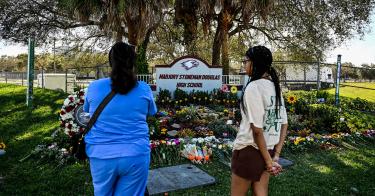Five years ago today, on February 14, 2018, a teen gunman walked into the halls of Marjorie Stoneman Douglas High School in Parkland, Florida, and murdered 17 people.
The shooting was all the more tragic for the several layers of official failure surrounding it. There were far too many missed warning signs that should have resulted in intervention, and a bungled emergency response that led to far more deaths and injuries than should have been possible.
And yet Florida’s commendable, effective response since that dark day has been almost completely overlooked. And it remains an incredible outlier among states that have suffered from high-profile school shootings.
It should be neither.
>>> We Have Effective Gun Violence Solutions. You Just Won't Listen.
Far too often, policymakers react to high-profile mass violence by defaulting to one of two standard game plans. Sometimes, they choose to do nothing. They accept a status quo that allowed an entirely preventable tragedy to occur, knowing that such events—while devastating—are nonetheless rare.
More commonly, though, they jump onto the runaway train of “just do something”—a dangerous basis for public policy, and one in which too few people spend time thoughtfully considering what, exactly, that “something” ought to be.
Almost reflexively, that “something” generally means “sweeping gun control measures.” These measures almost never bother to address the most significant factors underlying mass shootings, and almost always threaten to undermine the constitutional rights of millions of perfectly peaceable Americans.
Florida certainly could have chosen to do nothing. Parkland, for all of its horror, was an unprecedented stain on the state’s otherwise solid track record of keeping students safe from lethal violence at school. In fact, in the 18 years leading up to Parkland, only three Florida students were fatally shot inside a school building during the school day (and two of those were suicides).
But Florida leaders did not choose to do nothing. Nor did they yield to the pressure to “just doing something.” Rather, in the months following Parkland, they worked swiftly to assess the full scope of the problem and correctly diagnose what went wrong. They then invested in carefully considered solutions that, at least to a large extent, were directed at fixing actual problems and filling concrete needs.
They significantly improved how local, state, and school officials identify, assess, and handle potential threats within schools. The state now has standardized behavioral threat assessment tools and procedures, which must be implemented by every school’s mandated threat assessment team. Students have a readily accessible and highly publicized app to anonymously report threatening or violent behavior.
Florida schools are now required to facilitate early intervention by implementing multi-tiered systems that better connect students with evidence-based mental healthcare both on and off campus. There are minimum physical safety and threat response standards, and schools must annually assess their compliance with these standards.
>>> Biden Rejected School Safety Measures Without a Plan
Moreover, the state completely revised its training program for School Resource Officers with respect to crisis intervention and emergency threat responses. Forty-six counties now participate in the Coach Aaron Reis Guardian Program, through which over 1,000 school employees have been voluntarily trained to provide an armed response to on-campus active assailant incidents.
To be sure, Florida’s response wasn’t perfect. The state has no excuse for nearly eliminating the Second Amendment rights of its law-abiding young adults under the age of 21, and its so-called “red flag law” to disarm dangerous individuals suffers from several serious due-process concerns. And for all of its possibilities on paper, the new school safety and mental health policies will only ever be as effective as their actual implementation.
But on the whole, Florida’s students are better secured today against violent threats than they were five years ago—and not just from the rarest of violent threats, like targeted mass shootings, but also from the much more common “mundane” threats that stem from interpersonal disputes or mental health crises. And the systems around these students are better designed and better equipped to promote not just their physical safety, but their mental and emotional well-being.
This measured but determined response to tragedy shouldn’t be an anomaly. It should be par for the public policy course. Let’s hope other state policymakers take note.
This piece originally appeared in the Daily Wire




